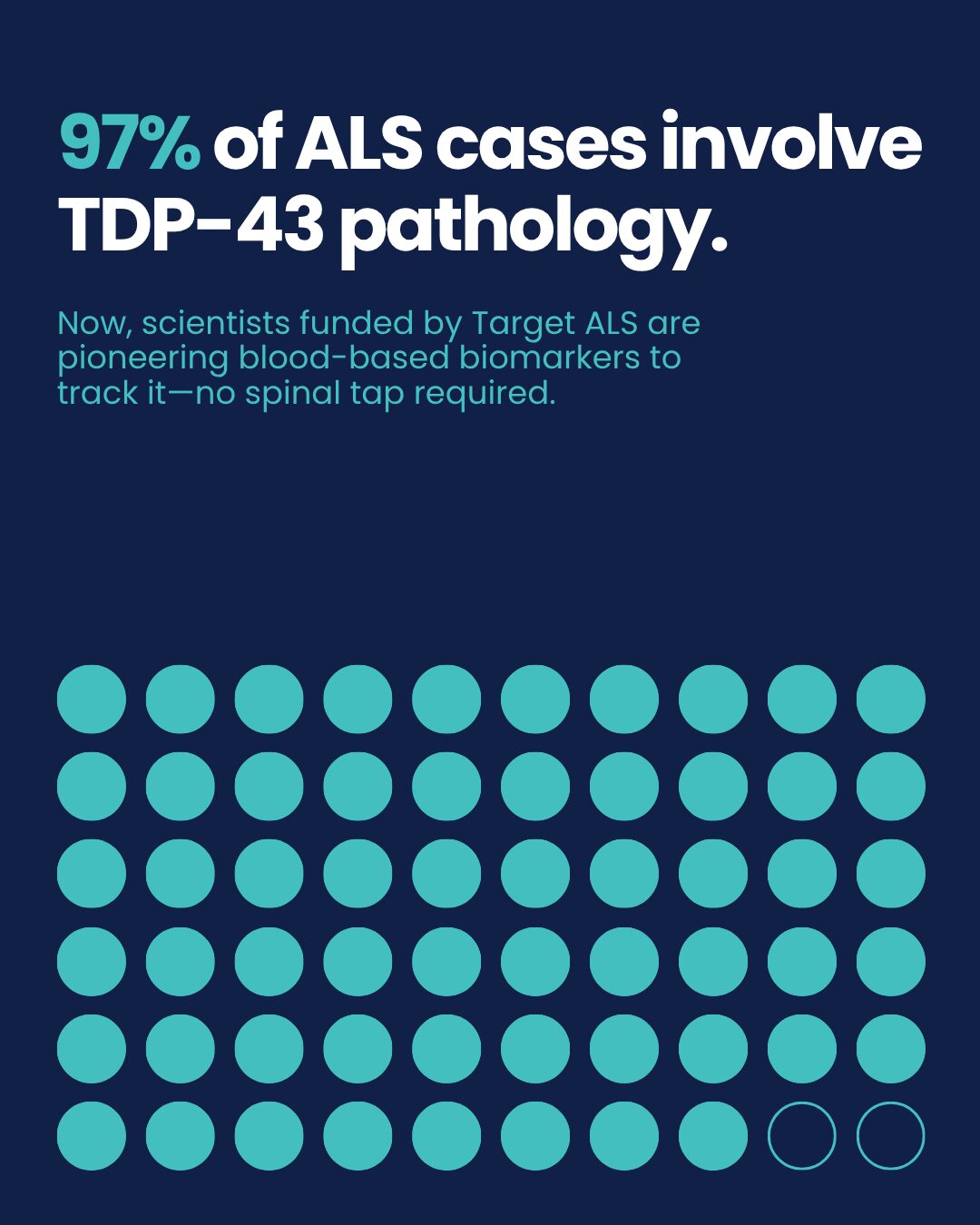By Ellen Guss, Scientific Programs Coordinator

At Target ALS, we are excited by the recent publication of the study “Tofersen treatment leads to sustained stabilization of disease in SOD1 ALS in a ‘real-world’ setting.”
Tofersen is the first RNA-based therapy approved for the treatment of SOD1-ALS and it received an accelerated FDA approval in 2023 based on lowering of Neurofilament light chain (NfL). The open label extension also indicated that tofersen treatment led to increased ALS-FRS-R scores indicating benefit on clinical symptoms. The phase III ATLAS study, a second study designed to confirm clinical benefit of tofersen, is still on-going. We are enthusiastic about the recent publication from a small, single-center observational study, showing a sustained clinical benefit with tofersen treatment.
Summary of Key Results
The study, which assessed the effects of tofersen on seven slow-progressing participants with SOD1 ALS, revealed several noteworthy findings:
- Serum Neurofilament Light Chain (NfL) Reduction: All seven participants demonstrated a reduction in serum NfL levels, a biomarker associated with neurodegeneration. These participants, both male and female, had diverse SOD1 mutations and were treated with Tofersen for periods ranging from 5 to 30 months. This decrease in NfL suggests a biological effect of tofersen on neurodegeneration.
- Slowed Disease Progression: The study included longitudinal assessment of ALSFRS (ALS Functional Rating Scale-Revised) in six of the seven participants. On average, the expected ALSFRS score without treatment was 28.7, while the actual ALSFRS score with tofersen treatment was 36.2. Since lower ALSFRS scores indicate greater disease progression, this 52% slower progression relative to expected outcomes suggests that tofersen was effective in slowing disease in these participants.
- Improvements in Muscle Strength and Mobility: Muscle strength improved in most participants, and the Functional Independence Score also showed improvement in all six participants for which there was enough data. Additionally, independent assessments (not conducted by the study’s authors) of gait and mobility revealed improvement in all participants, further underscoring the functional benefits of tofersen treatment.
- Quality of Life: Despite these improvements in motor function, participants reported no significant change in quality of life from baseline to post-treatment. This could indicate that while tofersen shows promise in slowing disease progression and improving physical function, further research may be needed to assess its full impact on overall quality of life.
Exciting Implications for ALS Treatment
These results are encouraging, especially for those with SOD1 mutations, as they mark an independent replication of findings in the Valor OLE suggesting that tofersen does slow clinical disease progression. What’s more is that tofersen not only slowed disease progression but also led to functional improvements—especially in areas like muscle strength and mobility—which offers hope for people with varying SOD1 mutations and may, in the future, have a benefit for those diagnosed with sporadic ALS (sALS).
This independent observation supports and extends the findings of the VALOR study, demonstrating clinically meaningful benefit in a small group of tofersen-treated participants. Most participants in this study were on tofersen treatment for much longer than participants in the VALOR study, demonstrating sustained benefit of the treatment almost three years after the initial dose. No serious adverse events were noted in these participants indicating that intrathecal delivery of ASO for an extended duration was safe and well-tolerated. This underscores the success of targeting known genetic causes of the disease and the need to continue to develop different therapeutic modalities that allow DNA and RNA to be targeted with high efficiency, safety, and easier delivery.
A Step Toward Preventative Treatments for Presymptomatic ALS
Beyond the “real-world” findings, these results also bring to mind another exciting development from the 2024 ALS/MND International Symposium, where the potential of tofersen in presymptomatic SOD1 ALS cases was highlighted. The ATLAS study, which is exploring this very idea, suggests that early intervention with tofersen in genetically predisposed individuals might have even more pronounced benefits. Early treatment could potentially prevent or delay disease onset, a concept that is particularly promising for families affected by SOD1 ALS, which often presents with rapid progression.
A Cautious Optimism
While the results are promising, the authors of the study note several important caveats. The study involved a small cohort, with participants at varying stages of disease progression and different durations of treatment. Additionally, ALS disease progression is inherently non-linear, making it difficult to predict precise treatment outcomes and estimate disease progression without treatment. The study also observed that tofersen benefited individuals with heterozygous mutations and no family history. Authors suggest that data might point toward benefit of the drug in sporadic forms of ALS but this would have to be studied rigorously in future research. Interestingly, Leavens et al. recently reported identifying pathological forms of SOD1 postmortem tissue from sporadic ALS cases.
Future trials should assess treatment response based on genotype, epigenetic factors, and other variables that could influence outcomes. Research currently being conducted by researchers like Moses Leavens and Steve Altschuler should also continue progressing, to determine if these effective genetic therapies can be applied to sALS individuals with fALS-like genetic and epigenetic signatures. This ongoing research will be crucial in refining our understanding of how genetic therapies like tofersen can be best applied to treat ALS.
Target ALS: Supporting Genetic Therapies for ALS
While Target ALS did not fund this specific study, we have long been a proponent of identifying genetic risk factors of ALS. Target ALS is dedicated to creating one of the largest existing Whole Genome Sequencing (WGS) datasets from postmortem tissue and non-neurological controls. Data from more than 300 cases can be found in the Data Engine, with new datasets added every quarter. This research, along with studies like the one on tofersen, plays a crucial role in advancing our understanding of ALS and developing new, targeted therapies. We are particularly excited about the potential of genetic therapies like tofersen to transform the landscape of ALS treatment and are committed to continuing our support for research that explores DNA and RNA-based modalities.
Moving Forward
The findings from this study give a much-needed boost to the ALS research community, demonstrating the therapeutic strategies targeting risk genes can indeed make meaningful changes in disease progression. As Target ALS continues to support groundbreaking research, we are accelerating the path to support not just ASOs but other new, promising modalities to treat ALS. Target ALS funds investigators who collaborate across scientific disciplines and research constituencies to drive medical breakthroughs for the treatment of ALS. Please look at our open funding calls or join our mailing list to learn more about upcoming grant opportunities.
We encourage you to read the full study for a more detailed look at the data:
Tofersen treatment leads to sustained stabilization of disease in SOD1 ALS in a “real-world” setting.
At Target ALS, we remain committed to funding transformative research that brings us closer to a world where ALS is no longer a fatal diagnosis. With ongoing breakthroughs like this, we can hope for a future where the progression of ALS is not only slowed but reversed, and where quality of life is improved for individuals and families affected by this devastating disease.





